Author: Tanay Ved Source: Coin Metrics Translation: Shan Ouba, Golden Finance
Key Points:
Circle generated $1.7 billion in revenue in 2024, 99% of which came from interest income on USDC reserves. Distribution costs paid to partners such as Coinbase and Binance totaled $1.01 billion, reflecting the key role of exchanges in expanding USDC's reach.
USDC's total supply has rebounded to $60 billion, with a 30-day average transfer volume of $40 billion - indicating a recovery in market confidence and cross-chain adoption. However, USDC remains highly sensitive to interest rate changes, competitive pressures, and regulatory developments.
USDC usage continues to grow on major exchanges, now accounting for 29% of Binance spot volume, thanks to Circle’s strategic partnership.
Looking forward, Circle’s next phase may depend on diversifying away from passive interest income toward active revenue streams related to tokenized assets, payment infrastructure, and capital markets integration.
Introduction
Circle, the largest U.S. stablecoin issuer and the company behind the $60 billion USDC, recently filed for an IPO, providing a window into the financial health and strategic outlook of a foundational company in the crypto space. As the only way to directly gain exposure to the fastest-growing vertical in crypto on the public markets, Circle’s filing comes at a critical time. While the IPO may still face delays due to market conditions, it comes at a time when stablecoin legislation is beginning to take shape and competition between issuers and blockchains is intensifying.
In this article, we dissect key takeaways from Circle’s IPO filing and combine them with USDC’s on-chain data to understand how Circle generates revenue, how factors like interest rates impact its business, and the role of platforms like Coinbase and Binance in shaping USDC distribution. We also explore USDC’s on-chain footprint to assess Circle’s positioning in an increasingly competitive landscape.
Circle’s Financial Overview
From its origins as a Bitcoin payments application to becoming a leading stablecoin issuer and crypto infrastructure provider, Circle has experienced a number of challenges in its 12-year journey. After explosive revenue growth in 2021 (450%) and 2022 (808%), growth slowed in 2023, when USDC was impacted by the collapse of Silicon Valley Bank and revenue grew 88%. By the end of 2024, Circle reported revenue of $1.7 billion, up 15% year-over-year, indicating a shift toward more robust expansion.
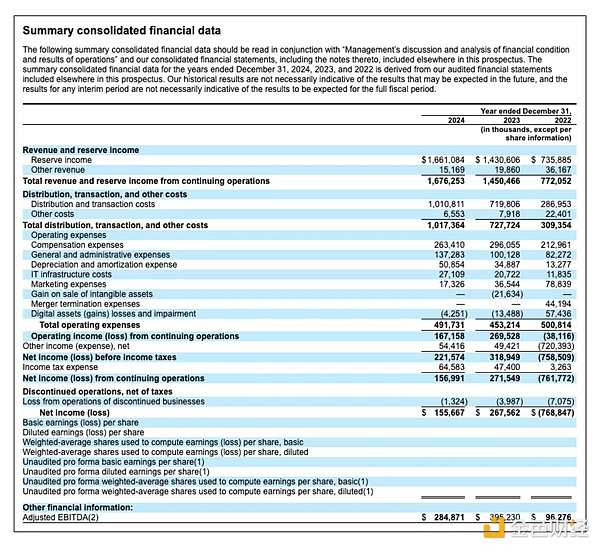
Source: Circle S-1 filing
Profitability declined, however, with net income and adjusted EBITDA falling 42% and 28% to $157 million and $285 million, respectively. Notably, Circle’s financials show that its revenue is highly concentrated in interest income from reserves, while distribution costs paid to partners such as Coinbase and Binance amount to approximately $1.01 billion. However, both factors have contributed to the recovery of USDC supply, which grew 80% to $44 billion for the year.
USDC’s On-Chain Growth
USDC is the core of Circle’s business and was launched in 2018 through a joint venture with Coinbase. USDC is a tokenized representation of the U.S. dollar that allows end users to store value in digital form and transact on a blockchain network, enabling near-instant, low-cost settlement. It follows a full reserve model and is backed 1:1 by highly liquid assets such as short-term U.S. Treasuries, overnight repurchase agreements, and cash held at regulated financial institutions.
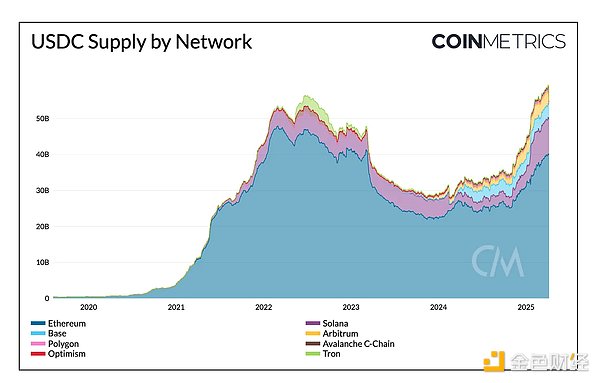
Source: Coin Metrics Network Data Pro & Coin Metrics Labs
USDC's total supply has grown to approximately $60 billion, firmly establishing itself as the second-largest stablecoin after Tether's USDT. Although its market share came under pressure in 2023, it has since rebounded to 26%, reflecting a return of market confidence. Of this, about $40 billion (65%) was issued on Ethereum, about $9.5 billion on Solana (15%), about $3.75 billion on Base Layer-2 (6%), and the rest on Arbitrum, Optimism, Polygon, Avalanche and other blockchains.
USDC's circulation velocity and transfer volume have also seen impressive growth, with a 30-day average of about $40 billion. In 2025, most USDC transfers occurred on Base and Ethereum, sometimes accounting for 90% of the adjusted total transfer volume.
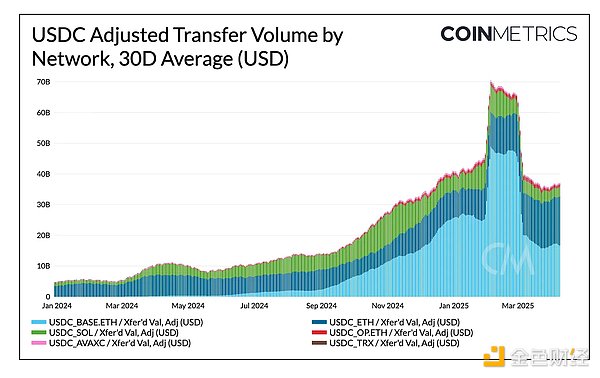
Source: Coin Metrics Network Data Pro
These indicators show that the use of USDC is growing as stablecoins become popular as alternatives to the dollar in emerging markets and in payment and fintech infrastructure. They also reflect Circle's cross-chain strategy, with USDC ubiquitous on major blockchains and supported by interoperability tools such as the Cross-Chain Transfer Protocol (CCTP).
Reserve Composition and Sensitivity to Interest Rates
For every dollar of USDC issued, Circle invests the backing reserves in a range of highly liquid, low-risk assets such as short-term U.S. Treasuries and cash deposits. This structure enables Circle to earn income from its reserves while ensuring liquidity and redemption stability for USDC holders. In its application, Circle revealed that it earned $1.6 billion in reserve income in 2024. This accounts for 99% of its total revenue, indicating that its income structure is highly concentrated in interest rates.
Most of USDC's reserves are held in the Circle Reserve Fund, a government money market fund registered with the U.S. Securities and Exchange Commission and managed by BlackRock. Based on Circle’s monthly certifications, financial statements, and the aforementioned BlackRock Circle Reserve Fund, we found that as of April 11, USDC’s reserves consisted of $53.5 billion (about 88%) of US Treasuries and overnight repurchase agreements with multiple financial institutions, all of which had maturities of less than 2 months. In addition, 11% of its reserves consisted of cash held at regulated banks.
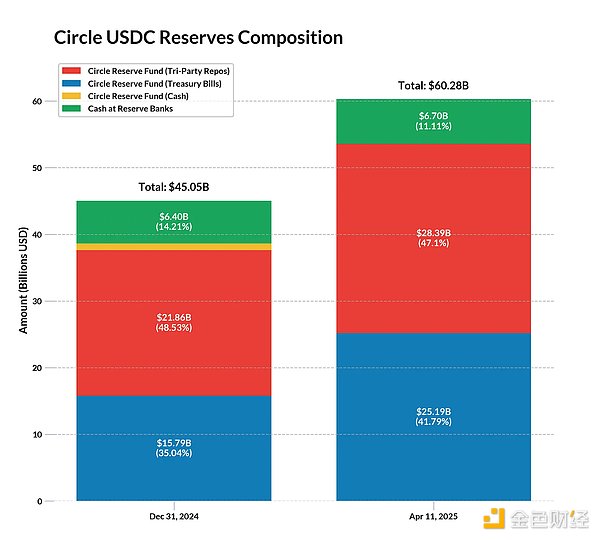
Source: Circle Transparency & BlackRock Circle Reserve Fund
Based on Circle's $1.6 billion in reserve income generated by approximately $44 billion in reserve assets in 2024, the implied annualized rate of return is approximately 3.6%. If interest rates remain near current levels, assuming that the USDC supply remains unchanged or grows, Circle's reserve income is likely to remain stable.
Our previous article focusing on the decline in USDC supply during periods of rising interest rates revealed a high correlation between Circle’s reserve revenue and the prevailing interest rate, indicating that its revenue model is highly sensitive to changes in interest rates. While the effective federal funds rate in 2024 is between 4.58-5.33%, what does this mean for Circle in a falling interest rate environment? In the S-1 filing, Circle estimated that a mere 1% drop in interest rates could result in a $441 million reduction in stablecoin reserve revenue, a key risk outlined in the filing.
Given that Circle retains all earnings — unlike issuers such as Ethena and Maker, which distribute interest to holders, its business model remains highly sensitive to future interest rate changes, competitive pressures, and regulatory evolution.
Distribution, distribution, distribution
The role of Coinbase and Binance
Circle's IPO filing also reveals the importance of partners such as Coinbase and Binance in promoting the popularity of USDC. In 2024, their distribution costs reached $1.01 billion, a sharp increase of 40% from 2023 and 150% from 2022.
While Coinbase's relationship with Circle is well known, the filing reveals how closely the two are financially tied together. Coinbase earned $908 million from USDC-related activities in 2024, accounting for about 13.8% of its total revenue. Under its revenue-sharing agreement with Circle, Coinbase earns 100% of the interest on USDC held on its platform and 50% of the interest on USDC held elsewhere. The USDC supply held on the Coinbase platform is currently 20%, up from 5% in 2022, and most of the economic benefits appear to belong to Coinbase. The filing also disclosed a one-time payment of $60.25 million to Binance, intended to promote distribution in a similar manner.
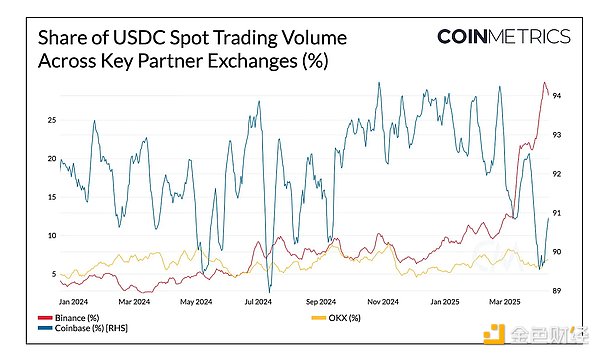
Source: Coin Metrics Market Data Feed
Looking at spot trading activity on major partner exchanges, USDC currently accounts for more than 29% of Binance's spot trading volume (about $6.2 billion), surpassing FDUSD after its recent unpeg. It is second only to USDT, which accounts for about 50% of Binance's trading volume. On Coinbase, USDC drives about 90% of spot trading in the combined USD and USDC markets.
Despite the high costs, Circle’s distribution efforts have translated into significant exchange-level adoption—driving USDC liquidity and over $10 billion in trusted spot volume on exchanges.
Beyond Exchanges: Enabling DeFi and Commerce
Separating the supply held in smart contracts from the supply in Externally Owned Accounts (EOAs) sheds light on the distribution of USDC across user wallets and applications on Ethereum. Currently, ~$30 billion is held in EOAs, up 66%, while ~$10 billion is in smart contracts, up ~42% from a year ago. The growth in EOA balances likely reflects an increase in exchange custody and individual user holdings, while the growth in smart contracts demonstrates USDC’s utility as collateral in DeFi lending markets and a source of liquidity on decentralized exchanges (DEXs).
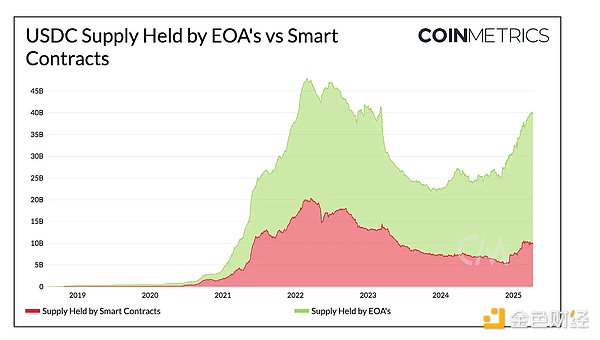
Source: Coin Metrics Network Data Pro
USDC continues to play a fundamental role in the DeFi lending market, with over $5 billion locked in protocols like Aave, Spark, and Morpho (representing the portion of USDC that has been supplied but not lent out). For collateralized debt protocols like Maker (now Sky), about $4 billion of USDC also supports the issuance of Dai/USDS through its price stability module.

Source: Coin Metrics ATLAS & Reference Rates
Similarly, USDC is a key source of liquidity for various DEX pools, facilitating the trading of stable value assets. It is also increasingly supporting the on-chain foreign exchange market, especially as other fiat-pegged stablecoins such as Circle's MiCA-compliant EURC gain momentum.
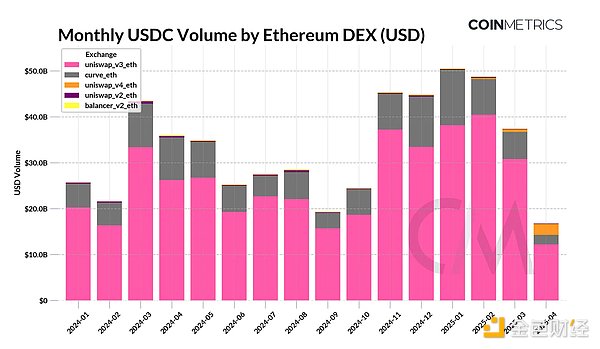
Source: Coin Metrics DEX Data
Conclusion
USDC's on-chain growth reflects the restoration of market confidence, but Circle's application documents also highlight key challenges, especially high distribution costs and heavy reliance on interest income. To maintain growth momentum in a low-interest environment, Circle is working to diversify revenue through active product lines such as Circle Mint and expand into the tokenized asset infrastructure space through the acquisition of Hashnote, the largest issuer of tokenized money market funds.
Circle is well-positioned as regulatory clarity improves, particularly with the U.S. Securities and Exchange Commission’s (SEC) stance that stablecoins are not securities. But it now faces growing competition from offshore issuers like Tether and a new crop of U.S.-based challengers looking to capitalize on the momentum of the policy shift. While Circle’s valuation remains to be determined, its IPO will mark the first time that public markets can invest directly in the growth of stablecoin infrastructure.
 Weatherly
Weatherly














